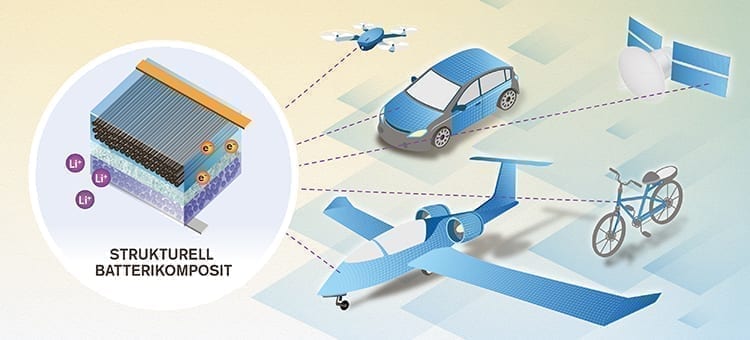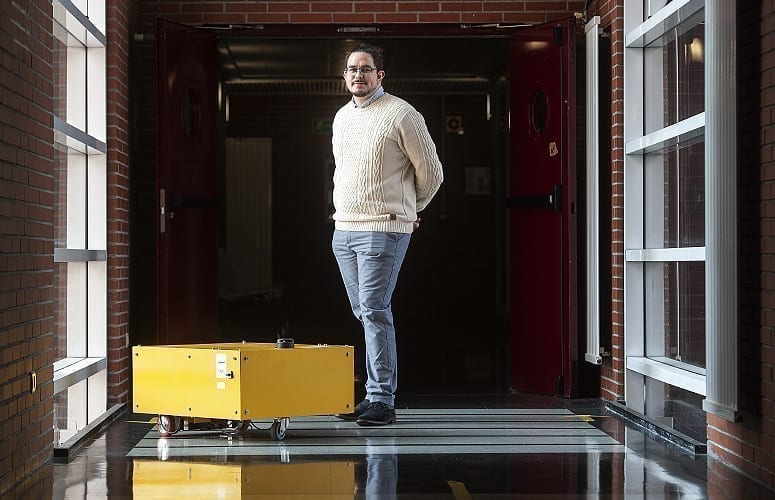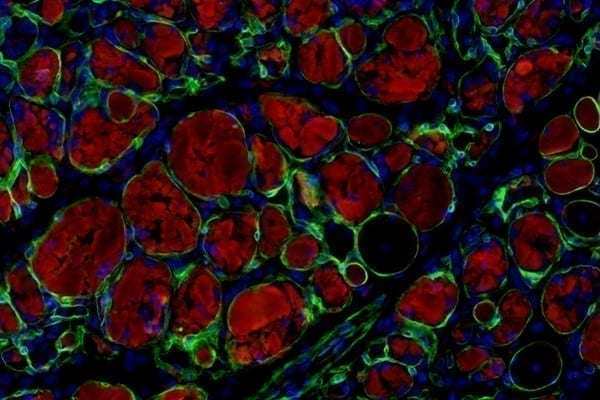
Researchers at Chalmers have in experimental studies produced a structural battery that is ten times better than all the previous ones. It contains carbon fiber that works in parallel as an electrode, current conductor and load-bearing material. The battery opens the door for so-called “weightless” energy storage in, for example, vehicles and craft.
The batteries in today’s electric cars make up a large part of the vehicles’ weight, nor do they fulfill any load-bearing function. A structural battery, on the other hand, can function both as a battery and be part of the structure in, for example, a car body. This is called weightless energy storage because the mass of the battery “disappears” when the battery becomes part of the load-bearing structure. Calculations show that with this type of multifunctional batteries you could greatly reduce the weight of a car.
The development of structural batteries is based on previous research where it was discovered that certain types of carbon fiber, in addition to being stiff and strong, also proved to have a good ability to store electrical energy chemically. These discoveries were named in 2018, by reputable Physics World, as one of the year’s ten biggest breakthroughs.
The first attempt to make a structural battery was made as early as 2007 at the Army Research Laboratory in the USA, but so far it has proved difficult to manufacture batteries with both good electrical and mechanical properties. Now, however, the development takes a real step forward when researchers at Chalmers, in a collaborative project with KTH, can demonstrate a structural battery with combined properties that far exceeds anything previously manufactured, in terms of electrical energy storage, rigidity and strength. If you look at the multifunctional performance, it is 10 times higher than with other structural batteries.
The battery has an energy density of 24 Wh / kg, which means approximately 20 percent capacity compared to comparable lithium-ion batteries on the market today. But since the weight of the products can be greatly reduced, not as much energy will be required to drive an electric car, for example. If you can use a lower energy density, safety will also increase. With a stiffness of 25 GPa, the structural battery can compete with several other construction materials.
Previous attempts to make structural batteries have resulted in cells with either good mechanical or good electrical properties. Here, by using carbon fibers, we succeed in demonstrating a structural battery with competitive energy storage capacity and rigidity, says Leif Asp, professor at Chalmers and leader of the project.
Super light laptops and electric bikes may soon be a reality
The new battery has a negative carbon fiber electrode, and a counter electrode made of a lithium iron phosphate coated aluminum foil. They are separated by a fiberglass fabric in an electrolyte matrix. Despite the fact that they have succeeded in creating a structural battery that is ten times better than all the previous ones, the materials were not chosen to break records, but to provide an increased understanding of the effects of material architecture and separator thickness.
A new project, financed by the Swedish Space Agency, is already underway, where the performance of the structural battery will be further increased. The aluminum foil will be replaced with a carbon fiber as a load-bearing material in the positive electrode. It will provide both increased rigidity and energy density. The fiberglass separator will be replaced with an ultra-thin variant, which will give a much greater effect, which also means faster loading and unloading. The new project is expected to be completed within two years.
Leif Asp, who is also leading this project, estimates that such a battery could reach an energy density of 75 Wh / kg and a stiffness of 75 GPa. This means that the battery is about as strong as aluminum but with a comparatively much lower weight.
– The next generation structural battery has very great potential. If you look at consumer technology, it will be quite possible within a few years to be able to manufacture laptops, smart phones or electric bikes that weigh half as much as today, and are much more compact. A smartphone, for example, could be built very thin, says Leif Asp.
In the longer term, it is definitely conceivable that electric cars, electric planes and satellites will be designed and supplied with energy by structural batteries.
Original Article: Big breakthrough for “weightless” energy storage
More from: Chalmers University of Technology | KTH The Royal Institute of Technology
The Latest Updates from Bing News & Google News
Go deeper with Bing News on:
Structural battery
- Battery firms urged to step up innovation, reduce output
It aims to guide the industry to accelerate the transition and upgrading process and structural adjustment ... "The high-quality development of the lithium-ion battery industry toward a more regulated ...
- ENNOVI Optimizes EV Battery Module Cell Contacting System Design with Advanced Capabilities
Latest research and detailed material testing promise to enhance the manufacturing efficiency, reliability, and environmental sustainability of EV batteries ...
- Lyten Ships Lithium-Sulfur Battery A-Samples for Automotive, Consumer Electronics, and Military Customer Evaluation
That is Lyten’s lithium-sulfur battery.” Lithium-Sulfur is considered a leapfrog ... that can reduce the amount of plastic used by up to half while maintaining structural and impact strength; and next ...
- Minor Injuries Reported Following Tesla Model Y Rollover Crash in China
Public Amazed by Survival of Occupants in Severe Tesla CrashProminent Safety of Tesla Vehicles Highlighted A recent rollover incident involving a Tesla Model Y in China Tesla’s reputation for safe ...
- EV Battery Recycling Gains Momentum
Despite the EU's regulatory moves, it is EV powerhouse China that leads the pack in battery recycling. According to the Boston Consulting Group, it boasts a recycling capacity exceeding half a million ...
Go deeper with Google Headlines on:
Structural battery
[google_news title=”” keyword=”structural battery” num_posts=”5″ blurb_length=”0″ show_thumb=”left”]
Go deeper with Bing News on:
Weightless energy storage
- Calorie Counting: The Worst Way To Lose Weight; Here's Why
Is nutrition more essential than calories for weight loss? People are trying to shed weight without effort, and one of the simplest methods they practise is ‘calorie counting’.
- Puravive: Can This Tropical Blend Of Nutrients Revolutionize Weight Loss?
Struggling to shed extra pounds is a common challenge. Puravive claims to melt stubborn fat by using tropical nutrients ...
- Best Weight Loss Supplements In Canada: 6 Top Strongest Diet Pills To Lose Weight
We might start contemplating the need to improve our diet and exercise habits, perhaps even investing in gadgets like step counters to track our activity levels. However, despite our best efforts, ...
- FitSpresso NZ - New Zealand: A Closer Look at the Controversial Weight Loss Supplement
FitSpresso NZ - New Zealand, marketed as a “coffee loophole” for easy weight loss, has generated significant buzz online. However, behind the hype, FitSpresso NZ - New Zealand appears to be an ...
- The Best Probiotics for Women Interested in Weight Loss
Branded content. Us Weekly has affiliate partnerships so we may receive compensation for some links to products and services. Women of all ages often struggle to lose weight. From stress to hormonal ...
Go deeper with Google Headlines on:
Weightless energy storage
[google_news title=”” keyword=”weightless energy storage” num_posts=”5″ blurb_length=”0″ show_thumb=”left”]









